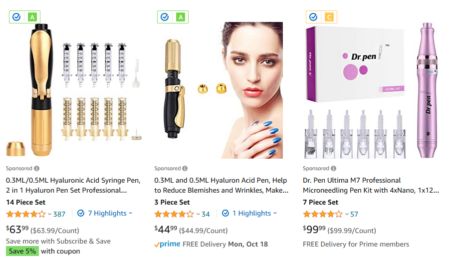J&J bankruptcy, facial acid warning, booster updates, and more
16 Oct 2021
Posted by Andrew Kantor
Don’t inject acid into your face
Despite what you may have heard on TikTok, Facebook, or from some random blogger or street-corner hobo, the FDA is warning that hyaluron pens are not safe at all. These home-use “dermal fillers” allow people to inject hyaluronic acid into their faces as sort of a Botox-on-the cheap. Without medical supervision.
Patients, it says…
…may not be aware of the serious adverse events that have been reported in connection with their use, such as permanent damage to the skin, lips, and eyes.
If you or someone you know ‘experiences adverse effects’ after self-injecting acid into your face, you can report that to the FDA … but take some photos first to grab a bit of Reddit karma.
Irbesartan recall
Lupin Pharmaceuticals is recalling all its irbesartan and irbesartan hydrochlorothiazide tablets due to a potential impurity. Lot and NDC numbers are on the FDA’s site.
ICYMI
booster club
The FDA approved a Covid-19 vaccine booster from Moderna. Expect the details to be the same as with the Pfizer boosters.
Meanwhile, an FDA advisory committee unanimously recommended Johnson & Johnson boosters at least 2 months after receiving their first shot. That needs to go to the FDA itself for approval.
FDA commish
Former FDA Commissioner Rob Califf and his mustache look to be on the hot list for the job. They served in the position under President Barack Obama.

J&J does the two-step
Johnson & Johnson has filed for bankruptcy. Sort of. The company it spun off to deal with the talcum powder lawsuits, LTL Management, has done so — as expected.
The tactic, commonly referred to as the Texas two-step, was first used by firms decades ago as a way to mitigate costs associated with asbestos claims.
Flu shots for the little ones
The FDA has the quadrivalent flu vaccine (flucelvax quadrivalent) for children as young as six months old. That is all.
The opioid crisis got worse
The latest CDC data show that the U.S. set a new 12-month record for drug overdose deaths, and that follows a record-setting 2020.
In that 12 months — a period when Covid-19 pandemic took hold in the United States and shut down normal daily routines — the US saw 96,779 reported drug overdose deaths, an increase of 29.6% from March 2020 to March 2021.
No prick necessary
Today, if you want to monitor glucose, you need either a needle and drop of blood, or a device embedded under the skin. But Penn State engineers have something new: a “noninvasive, low-cost sensor that can detect glucose in sweat.”
Of course it uses nanotechnology — a nickel-gold alloy, an atom-thick layer of carbon, and a microfluidic chamber … really, we all know it’s just magic. But if it’s magic that works outside a few grad students (the thing is just the size of a quarter), it could be good news for diabetics.



